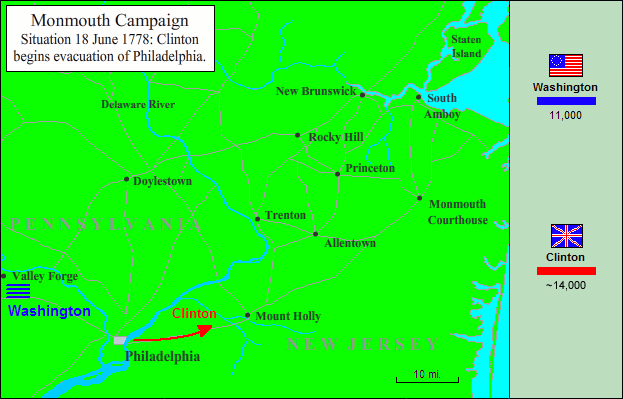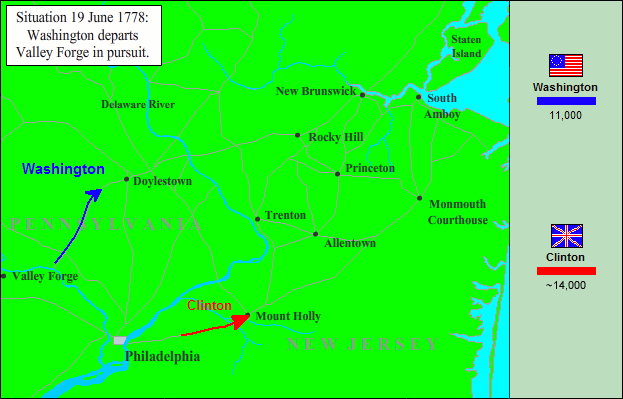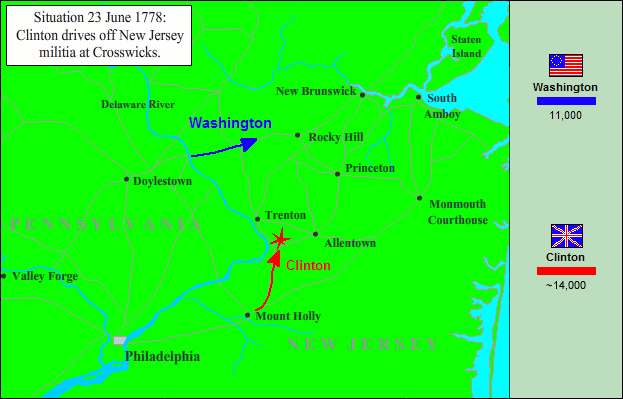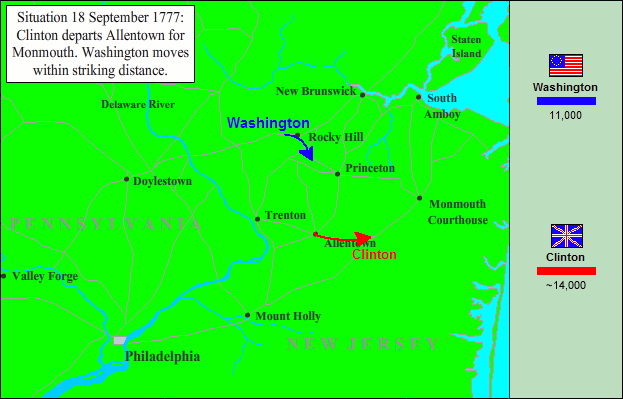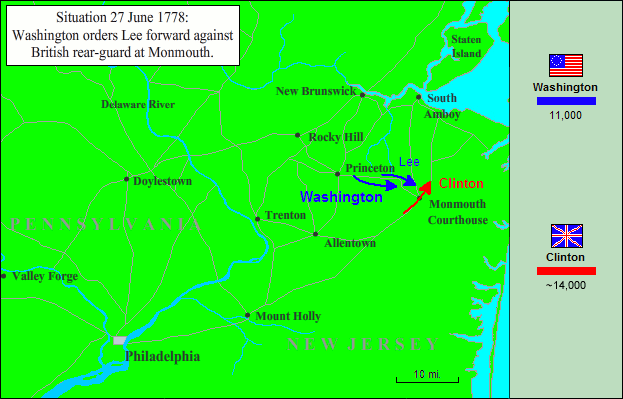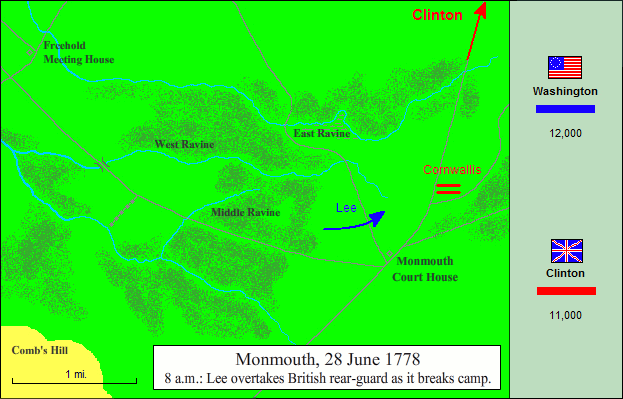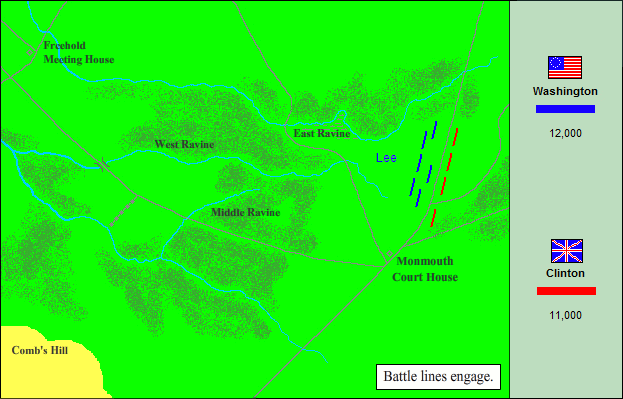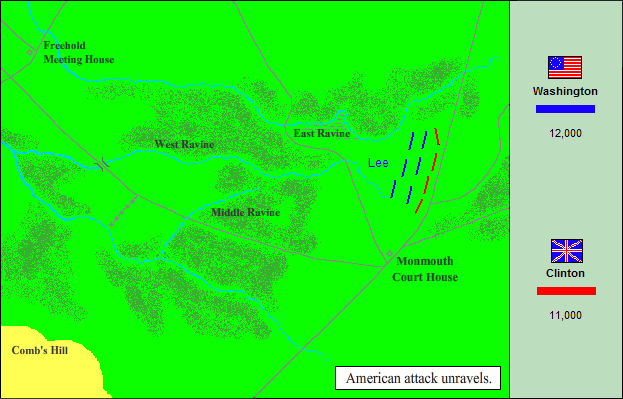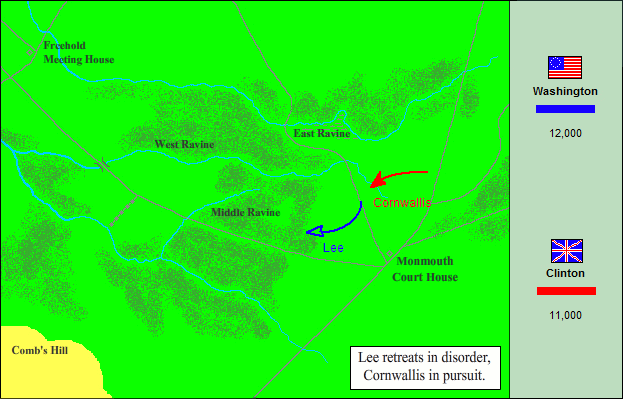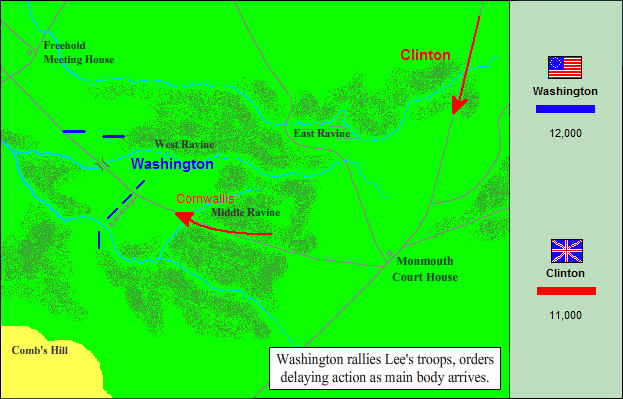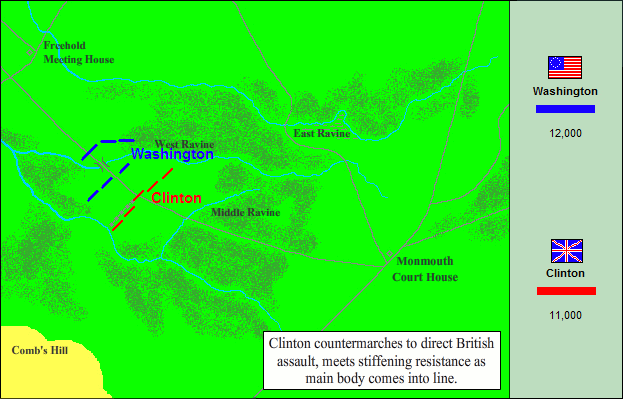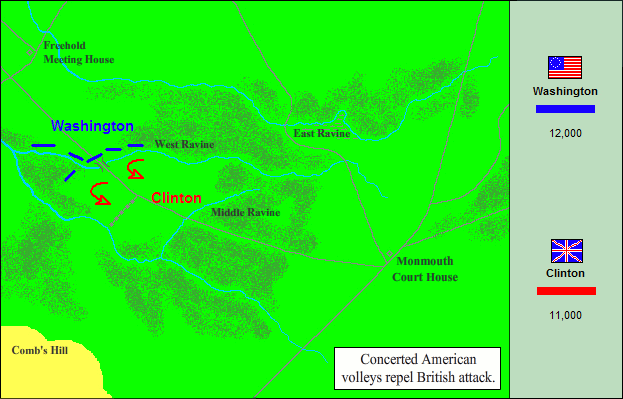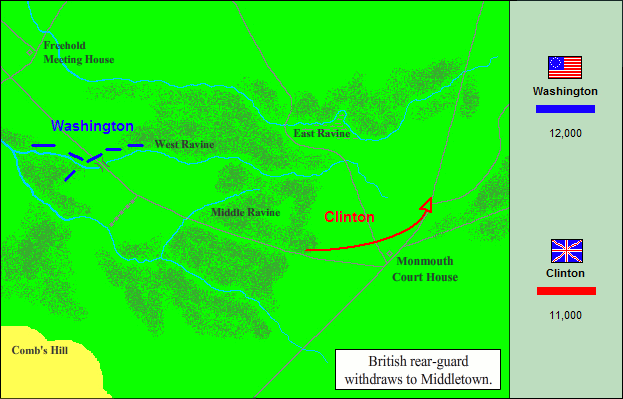Tell the Philadelphia ladies that the heavenly sweet pretty redcoats, the accomplished gentlemen of the guards and grenadiers, have humbled themselves on the fields of Monmouth.
–Anthony Wayne
Some students of the American Revolution argue that America would have won its independence regardless of the French alliance. America had after all sustained the struggle alone for three full years. Its Continental Line was shaping up into a formidable force, and its privateers were busy on the high seas, annoying if not seriously injuring the British effort. So long as Patriot America had the will to continue the contest, Great Britain would be compelled to send men and money across the stormy Atlantic and pour both into the vast distances of the American interior. Virtually absolute control of the sea on the part of Britain had not been decisive thus far nor had control of America’s few cities. At one point or another in the conflict, all of America’s principal cities–Boston, New York, Philadelphia, and Charleston–would be in British hands, but the war would go on. Still, it is difficult to exaggerate the significance of the French alliance: it forced the London ministry to stretch its resources ever thinner and to fundamentally shift its strategic thinking.
Its strategy thus far had hardly been coherent or effective, but its purpose had been reasonably clear and simple. Find a way, any way, to bring Washington to battle and crush his army. Cornwallis imagined that he was about to bag the fox on the banks of the Delaware back in the dark days of ’76, but the fox was alive and well and more cunning than ever. The French alliance, however, immeasurably increased Britain’s problems. Whatever it would or could do to strike Washington a crippling blow in the campaigning ahead, Britain now faced threats all over the globe. The island nation had to secure its sugar plantations in the West Indies; keep a watchful eye on French Canada; assure that neutral Holland remained neutral; protect the long sea route around the Cape of Good Hope; maintain its hold on India; even defend against a French invasion directly across the English Channel. Nor could Britain know when or if Spain, another long-time rival, would join forces with France. What was certain was that the Americans now had an ally prepared to challenge Britain’s supremacy at sea.
And if the tide seemed to be running against the London ministry just now, its patience with Sir William Howe was running out. He had spent the winter ensconced in Philadelphia. Both London and Loyalist America frankly wondered why Howe with an army nearly 20,000-strong did not march on Valley Forge then and there and fall on Washington’s ragged, starving, and shivering command. As one Loyalist wit urged:
Awake, arouse, Sir Billy,
There’s forage in the plain,
Ah leave your little Filly,
And open the campaign.
Howe would later argue that he was unwilling to undertake a winter campaign when he could accomplish his ends just as well in the spring, and that may be. But it is probably also true, as many suspected at the time of his appointment to the American command, that William Howe’s heart was not in this war. When Howe learned, in the autumn of ’77, that Burgoyne’s army had been taken off the board in the north country, and soon after that the ministry would not reinforce him, he asked Germain to relieve him from “this very painful service.” Early in February the king accepted his resignation and called on Sir Henry Clinton to succeed him, leaving Howe in command until Clinton’s arrival. (Of the “triumvirate of reputation” that arrived on the Cerberus in Boston in ’75, Burgoyne was a paroled prisoner of war and Howe had come to believe that the American war could not be won; only Clinton remained in the field by ’78.) If Howe had found his American service “very painful,” he found life in Philadelphia very pleasant indeed. In addition to the charms of his “little Filly,” Mrs. Loring, there had been balls, theatricals, horse racing, cockfighting, and of course the gaming tables. This social whirl he was most reluctant to leave. Although Clinton sailed in on 8 May to assume command, Howe lingered two weeks to enjoy one last, elaborate send-off. This “meschianza” (Italian for “medley”) was an extravagance of parade and pageant, dining and drinking, and nothing like it had ever been seen in America. There was a regatta on the river and jousting between the “Black Knights of the Burning Mountain” and the “White Knights of the Blended Rose”; costumed riders cavorted hither and yon; dancing went on until four in the morning under a “magnificent bouquet of rockets.” Except for the rockets perhaps, it was an incongruous affair to unfold in a theater of war and a strange–and to some, an unseemly–farewell to a stalemated general. As Howe’s secretary, Ambrose Serle, confided to his diary, “Our Enemies… will dwell upon the Folly and Extravagance of [the meschianza] with Pleasure. Every man of Sense, among ourselves, tho’ not unwilling to pay a due Respect [to Howe], was ashamed of this mode of doing it.”
Two weeks later Sir Henry Clinton was forcibly reminded that the empire was in fact at war. First came instructions from Germain to disperse his forces to meet the French threat. An expedition of 5,000 would have to go to attack St. Lucia in the French West Indies. Another 3,000 were to move south to St. Augustine and Pensacola in Florida where they might defend Jamaica or launch an offensive of their own against New Orleans. Most perilous was news that the French were already under sail out of Toulon and headed for America. Where they would make landfall was unclear, but if the powerful fleet under the Comte d’Estaing appeared at the mouth of the Delaware, Clinton would be in a very tight place. Accordingly, Germain ordered Philadelphia evacuated and the army shifted to New York. (Germain, never clear about the nature of the struggle he was trying to conduct from London, was prepared to fall back all the way to Canada.) Clinton would send most of his cavalry and artillery, two regiments of Hessians, some 3,000 Pennsylvania Loyalists and as much baggage as possible by sea to New York. The bulk of his army–some 9,000 troops–would march overland across New Jersey. A train of 1,500 wagons would have to rumble along with the marching column. Given the fact that the wagon train alone would extend a full twelve miles, Clinton’s strung-out column might afford the ever-watchful Washington an opportunity to strike a slashing blow.
Washington had expected the evacuation of the capital. In mid-May, about the time the British were preparing Howe’s send-off bash–Washington pushed some 2,200 troops eastward between the Delaware and the Schuylkill “to obstruct the incursions of the enemy’s parties, and to obtain intelligence of their motions and designs.” This detachment marched under the command of a French volunteer and unlikely soldier: Marie Joseph Paul Yves Roch Gilbert du Motier, the Marquis de Lafayette, scion of one of France’s most prominent families. He had come to America to fight British tyranny and perhaps to win a measure of glory for himself into the bargain. Though barely twenty-one, he was already a veteran with a reputation for nerve under fire, having caught a musket ball in the leg at Brandywine. Washington saw genuine promise in the youth, but warned him sternly to “guard against a surprise,” for he was committing a third of his effectives to this reconnaissance in force. Lafayette was careful but was caught anyway. Though Howe might dawdle all winter, Clinton could move swiftly when he wanted to and trapped Lafayette between the rivers. Clinton was so sure “the Boy” would stay trapped that he arranged a party at which the marquis was to be the featured guest. But Lafayette disappointed the company, kept his head and his command, and slipped across the Schuylkill at an undefended ford and back to the main army. American troops, trained by a Prussian and led by a Frenchman, were showing a new agility in the field.
Clinton was not ready to march for another month, for his army had a great deal to haul away from the plundered capital. Whatever Black Dick Howe could not sail away with, the foot soldiers would have to manhandle into wagons. With good reason military men refer to the baggage train as impedimenta: it impedes and encumbers. At 3:00 A.M. on 18 June Clinton got his ponderous column in motion. It took seven hours of hard hauling just to ferry the mass across the Delaware to Gloucester on the Jersey shore and begin the push east to Mount Holly. From that point, Clinton intended to march north for New Brunswick on the Raritan, cross the river there, and then on to Staten Island. It was slow-going: six days’ marching brought them just thirty-five miles to Allentown. Of course, Washington would have something to say about Clinton’s passage across New Jersey. Learning of Clinton’s departure early on the 18th, he gathered his general officers to seek counsel and make plans. The advice of this council–which now included Charles Lee, recently returned in a prisoner exchange–did not altogether please their aggressive commander. Except for Anthony Wayne and Nathanael Greene, the rest were disposed to do no more than harass Clinton’s flanks and Lee seems not to have wanted to do that much. This council of war, spat young Alexander Hamilton in disgust, “would have done honor to the most honorable society of midwives, and to them only.” For his part, Washington was not certain that he wanted to bring on a general engagement, but he was determined that Clinton would pay for his passage north. As ever, he was looking for an opportunity to fall on a part the enemy’s force with the bulk of his own, and if ever there were an opportunity, it would have to be somewhere along Clinton’s long, halting line of march.
Indeed, Clinton’s difficulties and Washington’s opportunities increased apace. Washington pushed his army out of Valley Forge the day after Clinton evacuated Phildelphia and started in pursuit. Five days later he had them across the Delaware at Coryell’s Ferry, and the day after that as far as Hopewell. They had covered nearly sixty miles in six days, a brisk bit of work for an army of 10,000. Washington’s numbers were, for once, actually increasing, for up ahead William Maxwell was already at Mount Holly with 1,300 and Philemon Dickinson was across the river with 800 New Jersey militia. These detachments had been busy too, destroying bridges, felling trees, stopping up wells, and generally making mischief all along Clinton’s line of march. While Washington was closing the gap between his van and Clinton’s rear, though, his lieutenants seemed no more eager to press on to a fight than when they set out. Most vocal was Charles Lee, who with a flourish urged Washington to build the Redcoats a bridge of gold to speed them on their way. American troops, he insisted, would never stand against the British at the point of the bayonet. Lee brought to the American camp a reputation as an eccentric genius, but thus far all his comrades had seen was the eccentricity. Steuben’s counsel was sound, however: catch Clinton’s strung-out column and strike it when it was on the march. Lafayette concurred, adding that there were twelve miles of acutely vulnerable wagons to strike.
Clinton was well aware of his danger, shadowed as he was by Maxwell and Dickinson and pursued by Washington. He also had reason to fear that Gates would march down from the Hudson and bar the way north at the Raritan. Crossing a river beset front and rear was not a pleasant prospect for the British commander to contemplate: it had disaster written all over it. Accordingly, he turned his line of march northeast from Allentown. This route would take his army through Monmouth Court House to Middletown, then on to Sandy Hook and safety under the guns of Richard Howe’s warships. It meant that he would not have to cross the Raritan, but it also meant that his army would be even more strung-out in the days ahead. From the Delaware crossing to Allentown, Clinton had marched in parallel columns on two roads, keeping the bulk of his infantry between Washington and the baggage train. Now one column would march a single road north: in the van Knyphausen marched with 4,000; creaking along in the middle were the wagons; bringing up the rear were 6,000 of the army’s fittest troops. Some 2,000 of these under Cornwallis made up the rear guard. Clinton pushed ahead on the 25th and reached Monmouth Court House late the next day. It was the best marching they had done thus far, but it was a punishing nineteen miles. The heat was terrific, and the men were laden like beasts of burden. Marching kit for the Redcoats weighed sixty pounds and the Hessians carried more than that. (In the next rebellion in America soldiers would learn to march with little more than a blanket, haversack, cartridge box, and musket, and Stonewall Jackson’s “foot cavalry” and Sherman’s wiry Westerners would perform prodigies of hard marching.) There was nothing really for Clinton to do now but put his men into camp at Monmouth and rest them.
Washington for his part lightened his load on the 25th. Leaving tents and baggage behind at Hopewell, he pressed on to Kingston just north of Princeton but still twenty-five miles from Clinton at Monmouth. At the same time, he detached Anthony Wayne, one of the few in his camp spoiling for a fight, and sent him with 1,000 New Hampshire Continentals to join forces with Maxwell and Dickinson already on Clinton’s flank in the neighborhood of Englishtown five miles west of Monmouth. Washington himself followed that night, and by the next morning most of the American army was likewise nearly to Englishtown. The general put them into camp to rest that day and the next. While the men rested, he called his lieutenants once more to a council of war. He was not seeking advice this time so much as assistance, for he had made up his mind to strike Clinton a blow before the opportunity slipped away. While Washington remained with the bulk of the army in support at Englishtown, an advance guard would pitch into Clinton’s rear as soon as the British column was in motion. Washington gave the command to Lee, who was after all his senior subordinate, but Lee, as prideful and brittle as ever, demurred, thinking it a more appropriate post for a junior officer. Washington now turned to Lafayette, and almost as soon as Lafayette got his orders, Lee thought better of his refusal and asked for the command. Washington now might have thought better about changing his mind, for he would be giving the responsibility for the attack to an officer who had said on more than one occasion that he did not believe it could succeed. But Washington agreed and it was settled: Lee would push forward with 5,000 men.
The heat was already hanging heavy in the air at 5:00 A.M of 28 June when Clinton got his column on the road out of Monmouth Court House and trudging northeast to Middletown ten miles away. As Knyphausen cleared the road ahead, the wagons began to creak and rumble, and perhaps an hour later the rear fell in and followed the train. All this took time, first Kynphausen’s 4,000, then 1,500 wagons, and finally 4,000 more men filing into column in the sticky heat. Cornwallis with the rear guard had barely cleared the courthouse town when Lee’s cavalry made contact about mid-morning. This contact was not exactly a bolt of summer lightning. Cornwallis was slow getting his infantry into position, and Charles Lee, much to the exasperation of his subordinates, seemed to have no idea how he wanted to make this attack. As Anthony Wayne later wrote to Washington, “no plan of attack was ever communicated to us.” Part of the problem was the ground itself, which neither side had studied carefully. Sandy pine barren country, it was cut up here and there by small streams and by three important ravines: East Ravine, closest to Clinton’s line of march; Middle Ravine, not quite two miles to the west; and West Ravine, another mile westward. It was nearly noonday before Lee’s infantry, with no direct orders and in no particular order, bumped into Cornwallis’ lines near East Ravine and about a mile north of Monmouth.
From this point, the battle seems to have fought itself, or rather individual units simply pitched into the roar of artillery fire as they thought best. The American advance, uncoordinated as it was, actually seems to have had some success on the left. Anthony Wayne was correct in supposing that the Americans outnumbered the British and called on Lee repeatedly–and vainly–for reinforcement to drive home an attack on this part of the field. But Lee had no idea what he intended beyond acting, as he said, “according to circumstances.” Whatever chance Wayne, Maxwell, and Colonel Charles Scott had of breaking through on the left suddenly slipped away when they discovered to their dismay that Lee had withdrawn on the right. Exposed as they were, especially Scott foremost in the advance, Wayne ordered a withdrawal. Thus, before the battle had been fairly joined, the whole American force was in retreat, some of it orderly, some confused. But just as Lee had given no order for an attack, he gave no direction to the retreat, not so much as communicating to his subordinates where he wanted them to stand and reform. He did send an engineer to the rear, who found a good position on high ground just west of Middle Ravine, but when Lee reached it, he didn’t like the look of it, and the whole, sweating, panting, frankly baffled American force simply stumbled down the Englishtown Road to no particular purpose.
Coming up the Englishtown Road just then was a tall rider on a fine white charger, their commander-in-chief. All he had heard from Lee thus far was a curt dispatch: “I am doing well enough.” Of course, continuing reports demonstrated that Lee was not doing well at all and that the slashing attack Washington intended had become a slovenly retreat. He found Lee soon enough. Descriptions of their encounter do not quite agree, but it seems clear that Washington was in a towering rage and gave free expression to it. “What is the meaning of this, sir?” Washington demanded. “I desire to know the meaning of this disorder and confusion.” Lee sputtered this and that about his threatened flanks and Clinton’s advance, adding to this his conviction that “American troops would not stand the British bayonets.” This last lifted Washington’s rage several notches: “You damned poltroon, you never tried them!” Washington had heard enough: he relieved him of command, sent him to the rear and eventually to a court-martial. He would deal with Charles Lee later. Now he rode into the heaving mass of retreating men. Lafayette was witness to this electric moment. Washington’s “presence stopped the retreat… his calm courage gave him the air best calculated to excite enthusiasm.” He rode “all along the lines amid the shouts of the soldiers, cheering them by his voice and example and restoring to our standards the fortunes of the fight. I thought then, as now, that never had I beheld so superb a man.”
There was to be hard fighting now in heat that soared to nearly a hundred degrees. Washington pulled together two brigades from the scattered units of Lee’s advance guard and threw them into line on a slight slope just east of West Ravine. He would make a stand here and blunt the British advance while the main body came up from Englishtown. The British pursuit was not long in finding and pitching into Washington’s two foremost brigades, but they stood long enough for Greene and Stirling to get into line behind them. They found good ground. On a ridge just behind West Ravine Stirling formed up on the left and Greene on the right. The American left was covered by a woodlot, and on the right was Comb’s Hill where Knox posted his artillery. Attacking Britons and Hessians would also have to cross a swamp on the American front. And attack they did. Clinton was on the field now and sent his brigades straight ahead into a battle that became a simple, brutal, five-hour slugging match under a broiling sun. The British came on with hard-headed courage, but Clinton did not handle them effectively this afternoon, throwing them piece-meal into uncoordinated attacks that the Americans broke up with disciplined volleys. Late in the day in a last desperate effort, Clinton threw Lieutenant Colonel Monckton’s tough grenadiers against Wayne’s men in the center, but this attack too was shot to pieces, Monckton himself killed at their head. As if to disprove Charles Lee’s convictions about the Americans’ willingness to meet the Redcoats at the point of the bayonet, Wayne now called for a bayonet charge of his own. For a time there was a ferocious heaving struggle as the grenadiers fought to recover Monckton’s body, but the British were eventually forced from the field, leaving their slain chief behind.
About six o’clock Clinton ordered a withdrawal all along his lines and fell back on Middle Ravine. As he later wrote, “our men were so overpowered with fatigue, that I could press the affair no further.” Washington thought he might press the affair further and in fact ordered two brigades forward in a counter-attack, but the exhaustion of his men and gathering darkness forced him to break off the fighting. Indeed, the combatants on both sides were bloodied and spent by this drawn battle that had cost each some 350 casualties, nearly as many to the heat as to musket balls. (Mary Ludwig Hayes earned an immortal name this day–Molly Pitcher–tending to both her artilleryman husband’s cannon in the heat of battle and to the wounded afterward.) Washington intended to renew the fighting in the morning, but Clinton, having saved his wagon train, withdrew in the night. Three days later he reached Sandy Hook and safety, leaving a trail of deserters, chiefly Hessian, behind him. Lord Howe would ferry the army to New York the next day.
Washington followed, crossed the Hudson at King’s Ferry, and pushed on to Westchester County. The Revolution was once more a “war of posts” as Washington drew a string of garrisons around Clinton from the Delaware to Long Island Sound. Washington might not be able to drive Clinton from Manhattan, but it would be difficult for the British to get out except by sea. The Battle of Monmouth Court House Washington always reckoned a victory, and in a sense it was. His Continentals had fought the best the British had to offer, and once they recovered from Lee’s blundering, fought them to exhaustion and drove them from the field. Perhaps Anthony Wayne did not exaggerate much when he said the British, for all their hard fighting, had “humbled themselves on the fields of Monmouth.” Just as important, by mid-summer of 1778 the two armies were almost precisely where they stood in the summer of 1776. Only New York and Newport remained in British hands. It was a prospect “not a little pleasing,” Washington wrote, “nor less wonderful to contemplate.”

